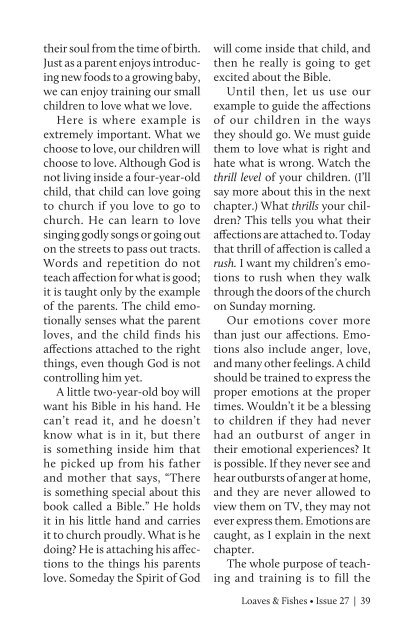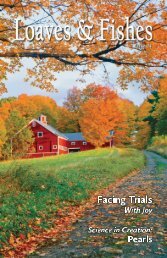Create successful ePaper yourself
Turn your PDF publications into a flip-book with our unique Google optimized e-Paper software.
their soul from the time of birth.<br />
Just as a parent enjoys introducing<br />
new foods to a growing baby,<br />
we can enjoy training our small<br />
children to love what we love.<br />
Here is where example is<br />
extremely important. What we<br />
choose to love, our children will<br />
choose to love. Although God is<br />
not living inside a four-year-old<br />
child, that child can love going<br />
to church if you love to go to<br />
church. He can learn to love<br />
singing godly songs or going out<br />
on the streets to pass out tracts.<br />
Words and repetition do not<br />
teach affection for what is good;<br />
it is taught only by the example<br />
of the parents. The child emotionally<br />
senses what the parent<br />
loves, and the child finds his<br />
affections attached to the right<br />
things, even though God is not<br />
controlling him yet.<br />
A little two-year-old boy will<br />
want his Bible in his hand. He<br />
can’t read it, and he doesn’t<br />
know what is in it, but there<br />
is something inside him that<br />
he picked up from his father<br />
and mother that says, “There<br />
is something special about this<br />
book called a Bible.” He holds<br />
it in his little hand and carries<br />
it to church proudly. What is he<br />
doing? He is attaching his affections<br />
to the things his parents<br />
love. Someday the Spirit of God<br />
will come inside that child, and<br />
then he really is going to get<br />
excited about the Bible.<br />
Until then, let us use our<br />
example to guide the affections<br />
of our children in the ways<br />
they should go. We must guide<br />
them to love what is right and<br />
hate what is wrong. Watch the<br />
thrill level of your children. (I’ll<br />
say more about this in the next<br />
chapter.) What thrills your children?<br />
This tells you what their<br />
affections are attached to. Today<br />
that thrill of affection is called a<br />
rush. I want my children’s emotions<br />
to rush when they walk<br />
through the doors of the church<br />
on Sunday morning.<br />
Our emotions cover more<br />
than just our affections. Emotions<br />
also include anger, love,<br />
and many other feelings. A child<br />
should be trained to express the<br />
proper emotions at the proper<br />
times. Wouldn’t it be a blessing<br />
to children if they had never<br />
had an outburst of anger in<br />
their emotional experiences? It<br />
is possible. If they never see and<br />
hear outbursts of anger at home,<br />
and they are never allowed to<br />
view them on TV, they may not<br />
ever express them. Emotions are<br />
caught, as I explain in the next<br />
chapter.<br />
The whole purpose of teaching<br />
and training is to fill the<br />
<strong>Loaves</strong> & <strong>Fishes</strong> • Issue <strong>27</strong> | 39







